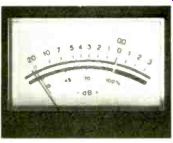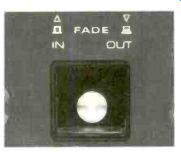The new Dual 819.
To fully appreciate what comes out of it, you should know what Dual engineers put into it.
The first time you listen to a recording made on the Dual 819, you'll know it's a high-performance cassette deck with superb specifications. Not only from the way it sounds, but from the positive feel of the operating controls, the quiet smoothness of the tape movement, the accuracy of the meters.
That may be all you need to know. But since you'll be more involved with your cassette deck than with any other component, we want you to know much more about the way Dual engineers designed the 819. And why you can expect many years of reliable performance from it.
Speed varies less than 0.05 percent.
It takes quite a drive system to keep tape speed variations below 0.05 percent at 1 7/8 inches per second. The 819's tape drive system starts with a high-torque DC servo motor whose speed accuracy is determined by an integral frequency generator.
The large speed-stabilizing flywheel-precisely machined and dynamically balanced-is coupled to the motor by a flat-ground drive belt. An independent belt handles the clutches and take-up spindle during play and record. A geared drive is switched in for the fast-wind modes.

----Dual's equalized meters prevent distortion when recording
high frequencies.
You can change from mode to mode in any sequence-even from fast forward to eject-as fast as you can press the switches. The tape will never spill or snarl--the innovative braking system engages the feed-spindle a split second ahead of the take-up spindle. And if the cassette-tape malfunctions, Dual's unique photoelectric tape-motion sensor stops the machine almost instantly.
Equalized record-level meters.
Although all cassette decks "equalize" the incoming signal by boosting the high frequencies, only decks with "equalized" record-level meters read this boosted signal.
Conventional meters read only the unequalized signal-which can lead to distortion when recording high frequencies. The 819 is one of the very few decks on the market with equalized meters.
The tape heads are hard Permalloy for the optimum combination of wide frequency response, low distortion and extended wear characteristics.
A four-point tape guidance system assures perfect tape-to-head alignment. The tape compartment door is viscous-damped. It opens smoothly and silently--and provides easy access to the tapeheads for cleaning.

---Dual's unique Fade/edit control lets you edit recordings after you've
made them.
Electronic fade/edit.
The 819's unique Fade/edit control electronically edits recordings during playback by selectively activating the erase head. You can fade out any unwanted sounds (commercials, for example) and then lade back into the music-while listening.
Plus all these features: Output level controls match the deck's output to your amplifier's.
Headphone-level controls. Memory-stop in both directions. Special limiter circuitry affects only potential recording overloads, not overall dynamic range. Bias/ equalization for the three basic types. And Dolby, of course.
Now you know quite a bit about the 819. Enough, we think, for you to visit a franchised Dual cassette deck dealer where you can see and operate it yourself. If you compare the 819 to much higher-priced decks you'll appreciate it all the more. And you'll know why.

Dual--United Audio, 120 So. Columbus Ave.
Mt. Vernon, NY 10553
---------
(High Fidelity, Jan. 1979)
Also see:
JVC turntables (ad, Nov. 1977)
FIVE MAINSTREAM SINGLE-PLAY TURNTABLES (review, Jan. 1979)